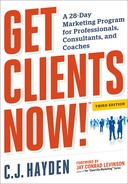WHAT WORKS AND WHAT DOESN’T?
In the Introduction, you learned the first secret of successful professional services marketing: Choose a set of simple, effective things to do, and do them consistently. Here is the second secret: Marketing a service business is not the same as marketing a product. Products are tangible; you can see them, touch them, maybe even taste them before you buy. Services are intangible. You can’t see them until they are demonstrated. They can’t be touched or tasted. Because a service is intangible, until it is performed for you, you have no idea how it will turn out, whether you will like it, or whether it will work for your problem, situation, or opportunity.
Therefore, when clients purchase a service for the first time, they must rely on their judgment about the person or organization delivering it. There is an old saying in sales and marketing: “People do business with people they know, like, and trust.” If a potential client gets to know you, learns to like you, and believes that he or she can trust you, you probably have a sale. Without your having at least one of those factors in place, getting the business will be an almost impossible task.
Keep this crucial rule in mind as you look at Figure 1-2, “Marketing Strategies for Professional Services.” This diagram operates on three levels simultaneously. First, it shows the six sales and marketing strategies that service providers can use. Second, it rates the strategies in order of effectiveness, from direct contact at the top to advertising at the bottom. We’ll look at each of these strategies in more detail later in this chapter, but notice that there is a strong connection between effectiveness and the know-like-and-trust factor. Strategies 1 through 3 are much more likely to create a personal relationship between you and the buyer than strategies 4 through 6. The exact order of the individual strategies on the diagram is unimportant, but the overall effectiveness ranking is critical to making the right choices about marketing. Direct contact and follow-up is an effective strategy all by itself, but advertising, used alone, almost never works to find clients for a professional, consultant, or coach.
Figure 1-2: Marketing Strategies for Professional Services

The effectiveness of any one strategy can vary with the situation and your own abilities and preferences. A psychotherapist, for example, would see that direct contact and follow-up with potential clients would be inappropriate, and therefore rely more on networking and referral building. A consultant who does poorly at public speaking would do well to avoid that strategy and concentrate on writing and publicity instead. But in any case where a particular strategy might not be best, you’ll have the most success if you choose another with the highest effectiveness rank possible.
Keep in mind that the effectiveness rating shown in the diagram for these strategies refers specifically to their use in marketing your own services or the services of your firm. This is what the Get Clients Now! system is designed to address. If your business also includes product sales as part of a service package, or as an added option for existing clients, rest assured that this diagram is completely relevant to your business.
For example, a chiropractor who sells nutritional supplements to his clients or a corporate trainer who suggests that training clients purchase her companion workbook will both find this ranking of strategies to be quite accurate. However, defining appropriate marketing strategies to sell products separately from your services—whether in your place of business or online—is outside the scope of this book.
The third level of information shown in Figure 1-2 is the impact that each strategy creates: outreach, visibility, and/or credibility. Knowing the impact of a strategy will also help you determine how to use it. Direct contact and follow-up is an outreach strategy, and networking and referral building is both an outreach and a credibility strategy. Public speaking and writing and publicity have the impact of both visibility and credibility, and promotional events and advertising have only the visibility impact.
Notice also that the impacts themselves have an effectiveness ranking. Outreach strategies are clearly the most effective, and visibility-only strategies are the least. Strategies that combine visibility with credibility are ranked in the middle.
Looking at this diagram, you may wonder where the Internet and social media fit in. How effective is online marketing or social media marketing compared to the six strategies shown here? The answer depends on how you choose to use the Web to market your business. The relative effectiveness of your online marketing activities follows exactly the same pattern as any other type of marketing you could choose. So online networking will be more effective than online publicity, for example, and writing for the Web will be more powerful than advertising on the Web. The Internet and social media are not marketing strategies in and of themselves; they are simply additional channels for employing a wide variety of marketing choices. You’ll learn more about these choices in the remainder of this chapter.
